Javan moss in an aquarium: how to grow and fix?
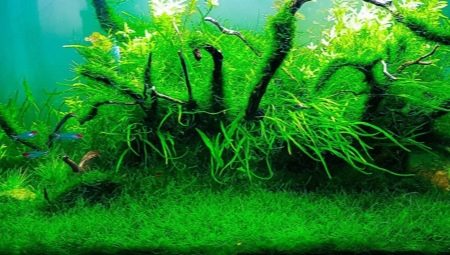
Javanese moss is a perennial aquatic plant, the decorative characteristics of which make it possible to beautifully decorate the aquarium. But it also often becomes a hiding place for fish and is used for spawning of some species of animals. Due to the fact that many consider it to be just a pretty algae, the bush often dies without proper care. It is worth figuring out how to take care of this wonderful representative of the underwater flora.
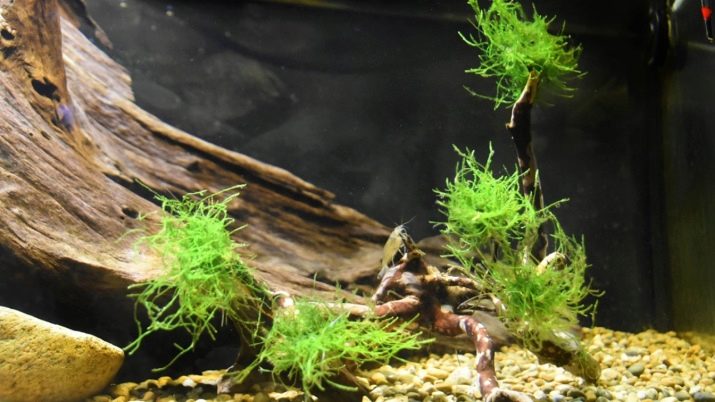
Description
Javanese, as aquarists also call it, refers to hypnum mosses. For the correct cultivation of this aquarium plant, you do not need to comply with any special requirements regarding the parameters of water and lighting, which differ from the content of other species of plants and fish. In addition, moss is able to grow not only in the soil, but also on the surfaces of stones and driftwood, even on the walls of the aquarium, since it does not have a root system.
Properly planted and positioned, this underwater dweller can make the design of an artificial reservoir unique.
But this feature of the hydrobiont also has a drawback - it clogs the filter and is able to grow on decorative elements and other plants.
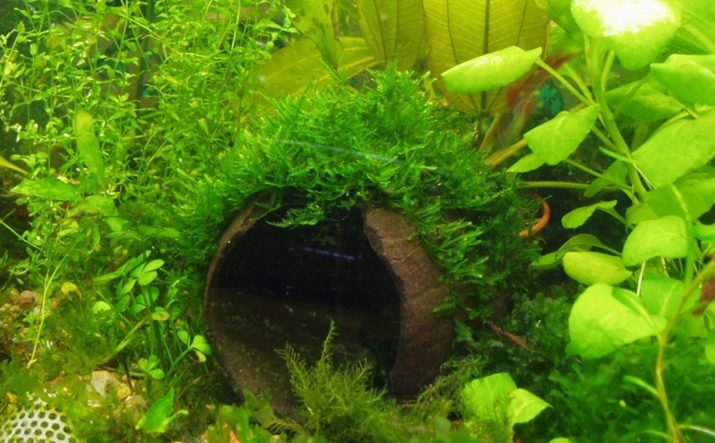
True, in this case, the moss is an epiphyte, that is, it does not parasitize on them. Moreover, it performs a useful function - it absorbs decay products and harmful components that accumulate in the aquatic environment over time.
I must say that this feature is characteristic of many tropical plants, both aquatic and terrestrial, and the Javanese is native to Southeast Asia. By the way, its name comes from the name of the island of Java, on which it also grows in large numbers.
The appearance of the aquatic animal:
- the plant has a thin, soft and long stem (from 17 to 45 cm);
- the leaves are small, thin, up to 2 mm, with sharp tips, their color depends on the degree of illumination and the level of oxygen: the younger ones are light green, and the older ones darken over time;
- also the Javanese has many tiny rhizoid organs - peculiar roots in the form of threads, with the help of which it is attached to glass and various objects;
- the plant can be located both on horizontal and on steep surfaces.
Javanese moss in an aquarium can form a real soft green carpet that looks quite exotic, but first you need to grow it and fix it so that it does not creep.

Growing conditions
The content of Javanese is associated with several important points, one of which is the presence of a filter system, since moss prefers clean water.
With severe pollution, the plant, which itself absorbs the remains of organic matter, can get sick and die. This is due to the fact that his pores are clogged.
Therefore, it must not be allowed that there is turbidity in the aquarium and there are a large number of suspended particles.
Water characteristics suitable for vegetation:
- the water temperature is from +23 to 30 degrees, the Javanese does not grow in a cooler environment;
- optimal hardness - no more than 15 units;
- if brackish water is needed for other inhabitants of the aquarium, it will not interfere with the development of vegetation;
- acidity is desirable to maintain at a level of 5-8 units. By the way, this parameter is suitable for most ornamental tropical fish, with which the plant can comfortably coexist.
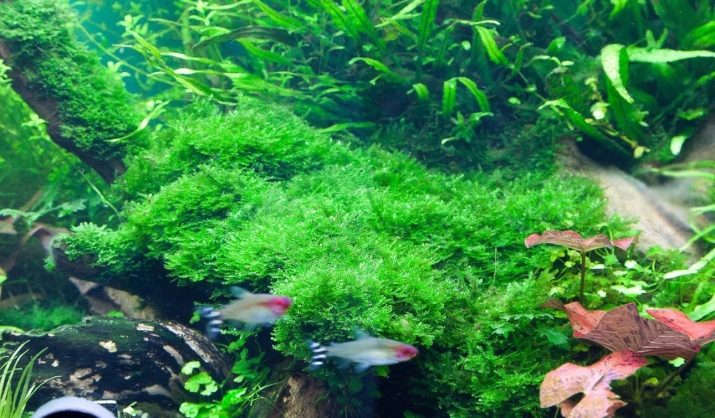
Moss is indifferent to light, but if you need it to grow quickly, you can make the lighting brighter, while its color will also become more saturated.
If it is possible to create a small current in the aquarium, this will have a beneficial effect on the development of young bushes.
Javanese moss is best grown in a large aquarium with a volume of 100 liters, but if desired (as a decoration for the back wall), a more modest 54 liter tank is also suitable, especially relevant in this regard Aquael 60 ECO with compressor and internal filter.
Such vegetation does not need soil, but it will have to be attached to wood snags, stones or decorations to avoid uncontrolled growth. Since the moss is periodically covered with bloom, it must be rinsed in clean water.
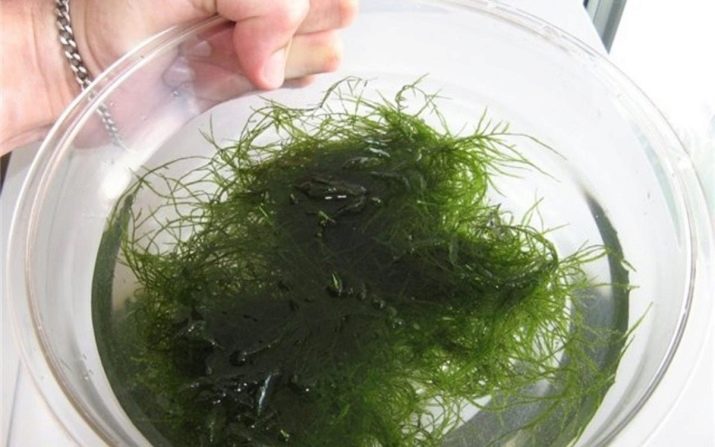
It is often undesirable to change water in a container; it is also not recommended to transplant the bushes to other places every now and then.
Equally important for any aquarium flora, including Javanese moss, carbon dioxide supply, but feeding is not necessary for him, since the plant takes any fertilizers from its environment.
Enemies of javanese moss in artificial habitat are blue-green algae and fringed growths of the "black beard". These are aquarium parasites that appear due to too low acidity and stagnant water. They can lead to the death of the plant, so they should not be allowed to appear.
The Javanese looks picturesquely on stones and snags, where it is also fixed. It is allowed to occasionally cut the plant for decoration purposes.
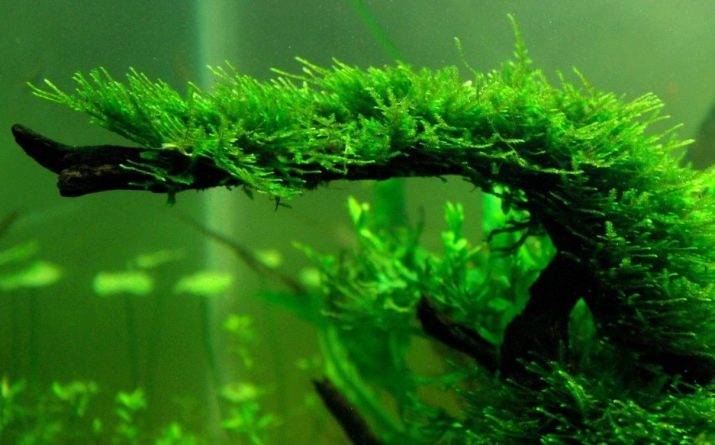
Reproduction and planting
With normal lighting and clean water, the plant can grow and multiply rapidly. This happens in a vegetative way: a bunch is separated from the main bush, growing up, it will also give a daughter bush. If the vegetation is located in the upper layers of the aquarium, then reproduction is carried out by spores: the shoots on the stem turn black, with oval shells filled with spores visible on them. As they fall, they form young Javanese bushes. But if in the aquarium, in addition to vegetation, fish live, then this phenomenon does not happen very often.
Planting Javanese Moss is quite simple:
- first, it is necessary to disinfect the selected surface with a 3% solution of potassium permanganate in order to protect other underwater inhabitants;
- after that, small bushes are laid out at a short distance from each other and fixed.
To fix the plant to the aquarium object, use a thread, fishing line or fine mosquito net for windows, as long as it is made of non-toxic material. The moss is carefully placed on a decorative object, covered with a net or wound with a thread, and then the material at hand is pressed to the ground using stones.
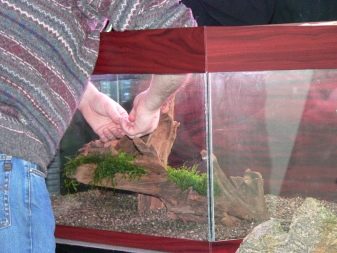
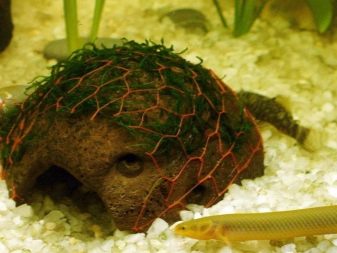
If it is necessary to fix the hydrobiont on the soil, it should be noted that you cannot bury it deeply, since the underwater inhabitant will have nothing to breathe... After that, you need to provide good lighting - at least 8 hours a day, and then the vegetation will rapidly grow.
The fixing material can be removed after 6-7 days, as the bush will have time to gain a foothold. This must be done carefully so as not to damage the delicate stems.

The epiphyte placement options are different.
- They can decorate the back wall of the tank; for this, the moss is fixed with a net, having previously provided it with suction cups.
- But there are more original ideas, for example, to create a tree using moss. To do this, you have to find a beautiful and heavy snag with twigs and a rough texture on which the fishing line or threads will not slip. The base of the tree is buried in the soil so that the moss cannot pick it up.
- In addition, ready-made Javanese moss rugs and spectacular moss balls can be purchased in the aquarium departments.
Javan moss gets along well with any species of fish that need the same conditions for normal life. Even for predatory species, its bushes are not of interest as food, with the exception of rare cases when its tiny leaves in a minimal amount can serve as feeding fry.
Experienced aquarists plant the water fern bolbitis and creeping anubias bushes in an aquarium with Javanese, which, in combination with a mossy carpet, look especially impressive. But other aquarium herbs can be placed next to the Javanese.
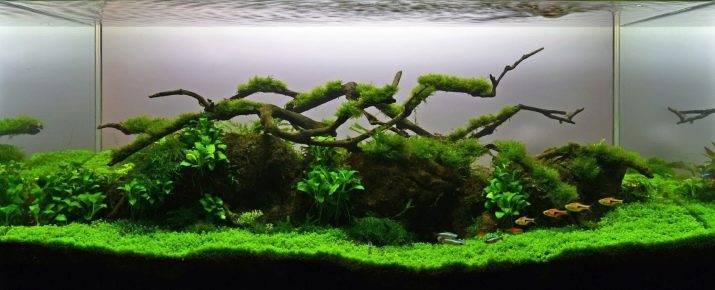
You can learn more about Javanese moss by watching the following video.








